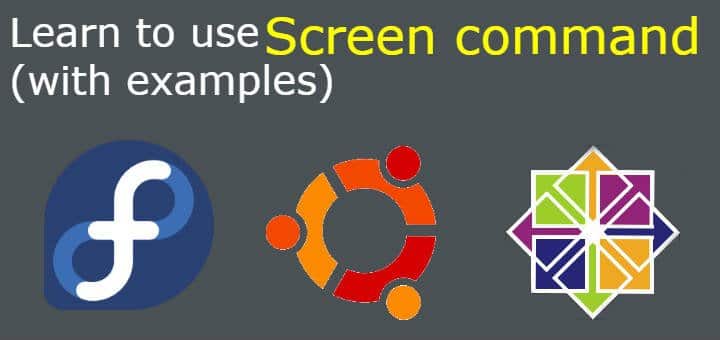Screen command is a very important command that provides the ability to launch & use multiple shell sessions from a single ssh session. When a process is started with ‘screen’, we can detach that process from session & than can reattach the session at a later time.
This is extremely useful for the cases where we need to run a process that will for a long time & a network disruption is expected. In this tutorial, we will learn to install screen command & will learn to use screen command with examples.
(Recommended Read: Learn to use Wget command with 12 examples )
(Also Read: Beginner’s reference guide to NMAP command )
Installation
Install screen command on with the following command,
CentOS/RHEL
# yum install screen –y
Ubuntu/Debian/LinuxMint
# apt-get install screen –y
Fedora
# dnf install screen –y
Screen command with examples
Start a screen session
To start a screen session, open terminal & run the following command
# screen
This will start a screen session & all the commands executed after this will be executed in screen session. We can also start a screen session with the command that need to be executed in screen session,
# screen ./test.sh
Starting a named screen session
To start a named session, we will use ‘S’ option followed by session name,
# screen –S http_install
This is especially useful when we are dealing with multiple screen sessions.
Deattach screen session
To deattach the current session , we need to press ‘Ctrl + A + D’ keys from the keyboard.
Attach a session
After a session has been deattached, we can attach it again. To do this, first run the following command to check the list of deattached screen session,
# screen –ls
We can than reattach the screen session with ‘r’ option followed by either session name or session number,
# session –r 11335
here 11335 is my session number, replace it with your session number.
Or
# session –r –S http_install
Using multiple screen session
We can use multiple screen session at any time. We can either create a new session after detaching the current screen session or we can create a new screen while current session is underway. This is called nested screen.
To make use of nested screen, we will create a new session by pressing ‘Ctrl + A + c’ & than can shuffle between the session using the key combination ‘Ctrl + A + N’ to goto next screen and ‘Ctrl + A + P’ keys to goto the previous sessions.
This was our brief tutorial on how to use screen command with examples. Please do let us know if you have any questions/queries using the comment box below.
If you think we have helped you or just want to support us, please consider these :-
Connect to us: Facebook | Twitter | Google Plus
Donate us some of you hard earned money: [paypal-donation]
Linux TechLab is thankful for your continued support.

shoudn’t # session –r 11335
be screen -r xxx ?
Definitely, i just mentioned the id for my session.
screen -x screen_name (for using status attched)